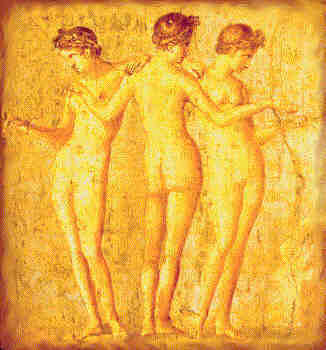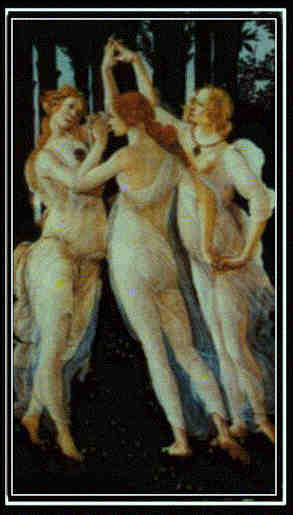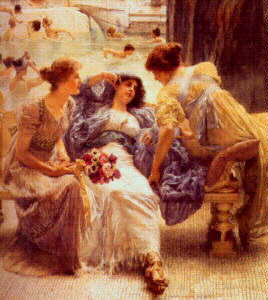

| Many mythic traditions have visualized the Goddess as facets of trinity or a triple trinity. Especially dear to our family triad are the depictions of the Three Graces and the Nine Muses in Greek and Roman art. |

|
The Chárites (Gratiæ) are beautifully celebrated in Botticelli's
renowned painting, la Primavera (c.1478). Typically they
are identified as Aglaia, " Brilliant One " ;
Thalia, " Bringer of Flowers " ; and Euphrosyne,
" Joy of the Heart " , appearing much as they did on a plaque from
Roman Cyrene, sixteen centuries earlier. Even more ancient are the names Melete, " Meditation " ; Mneme, " Remembrance " ; and Aoide, " Song. " These bring to mind such Maiden-Mother-Crone trinities as Hebe-Hera-Hekate, Iuventas-Iuno-Minerva, and Manát-`Uzzá-Allát. It is as the Nine Muses, inspirers of arts and sciences, that we know them best. About twenty-three centuries ago, Ptolemy Soter dedicated the Museion at Alexandria, sacred to the Muses, honoring the divine creativity of the human spirit. As the original museum it was the prototype of great repositories of art and learning, graced in its latter days by the presence of noble Hypatia, hailed widely as a living Muse. The Nine Muses are the daughters of Mnemosyne, " Sacred Memory " , and Zeus, with Thalia retained as patroness of comedy. Melpomene inspires tragedy and Terpsichore, the dance. Sacred poetry and pantomime are the province of Polyhymnia, Calliope for epic poetry, and to Erato the lyric poetry of love. Euterpe is devoted to the flute, Clio to history, and Urania to the study of the starry heavens.
|

|
"It is the Muses who have caused me to be honored; they taught me their craft ... " --- Sappho. |

* SCRIPSIT IVLIA VOPISCA KAL.. MAR. A. V. C. MMDCCLI (1998) *